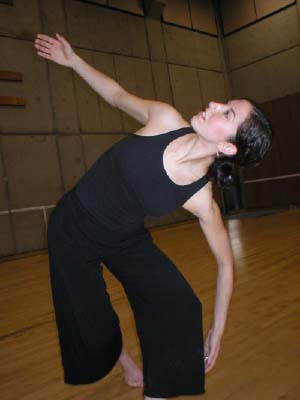|
In college, at the University of Illinois at Champaign-Urbana, Ebert fell in love with modern dance. She says it appealed to her because there wasn't as much of a focus on technique and classical line, yet she could still dance with a lot of physicality and emotion. She describes the school as having a "conservatory atmosphere," where most of her time was spent in the studio. There were requirements for reaching a certain level of technique and requirements for how often she performed. It was an excellent program, she says, but graduation left her feeling a little lost. She was not required to take many classes outside her department. "I was prepared to dance," Ebert says, "and when I got out of school it was like, OK, I can dance, but how do I live? How do I pay my rent in Chicago, because I can't do it dancing!"
Ebert auditioned for the Chicago company Hedwig Dances the fall after she graduated from college, but she didn't get in. Two years later the group had another audition. She says she wasn't really interested in trying out again, so she didn't go. Then someone from the company called her, asking her to come for round two, and she ended up with a place in the company anyway. "Everything was pretty easy," Ebert admits. Hedwig Dances had funding from the city. As a part of the deal, members of the company taught classes at a Chicago community college. Only three years out of school, Ebert was being paid to do what she loved. The abstract nature of modern dance often puts Ebert in the position of having to define what it all means. Searching for a suitable comparison, Ebert says modern dance is to ballet what an e.e. cummings poem is to a Shakespeare play, or a Picasso to a Monet. Modern dance is about energy, shapes and different kinds of movement. "I am a person dancing, but it's not like I am a character," Ebert says. "I'm not being myself, but I'm not being a woman from the 17th century, or a thing from the future. I am just a body, like a prop in space." Though it wasn't a part of her original plan, Ebert says, she feels lucky being at the University of Oregon, because it has provided her with an entree to the West Coast dance scene. Her classmates Tim and Corrie Cowart, who have danced in Seattle and Los Angeles, have introduced her to choreographers and performers in the dance community. "It's all about who you know a lot of times," Ebert says. "It's really frustrating at times, but at other times I'm like, OK, I've only been here a year. I don't really know anyone yet, so my dancing has to speak for itself." |
